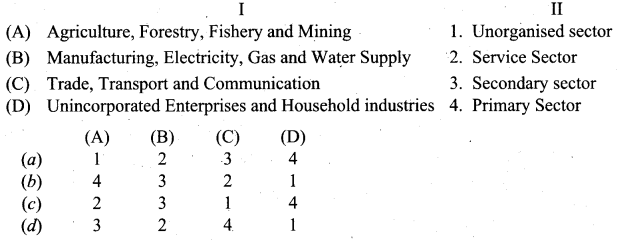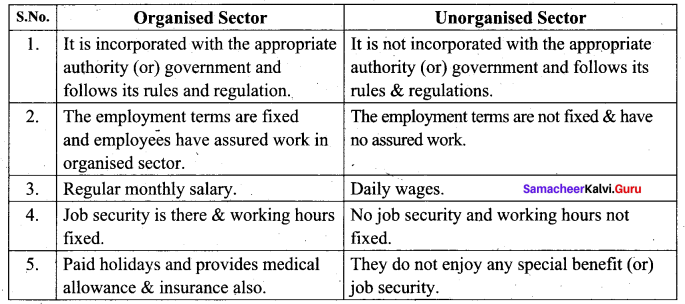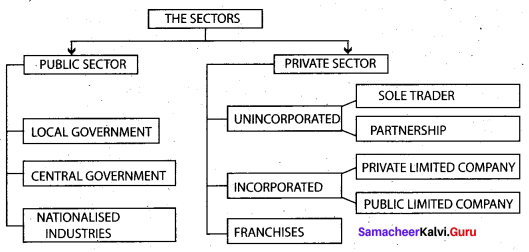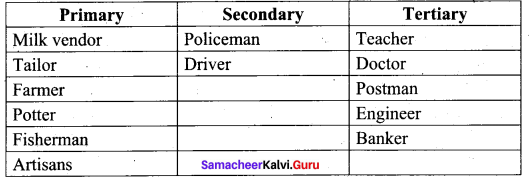You can Download Samacheer Kalvi 9th Social Science Book Solutions Guide Pdf, Tamilnadu State Board help you to revise the complete Syllabus and score more marks in your examinations.
Tamilnadu Samacheer Kalvi 9th Social Science Economics Solutions Chapter 2 Employment in India and Tamilnadu
Employment in India and Tamilnadu Textual Exercise
I. Choose the correct answer.
Question 1.
We take age group …….. years for computation of the workforce.
(a) 12 – 60
(b) 15 – 60
(c) 21 – 65
(d) 5 – 14
Answer:
(b) 15 – 60
![]()
Question 2.
Which is the correct sequence of various sectors in GDP of India in the descending order?
(a) Primary sector, Secondary sector, Tertiary sector
(b) Primary sector, Tertiary sector, Secondary sector
(c) Tertiary sector, Secondary sector, Primary sector
(d) Secondary sector, Tertiary sector, Primary sector
Answer:
(a) Primary sector, Secondary sector, Tertiary sector
Question 3.
Which one of the following sectors is the largest employer in India?
(a) Primary Sector
(b) Secondary Sector
(c) Tertiary Sector
(d) Public sector
Answer:
(a) Primary Sector
![]()
Question 4.
Which one of the following is not in Primary Sector?
(a) Agriculture
(b) Manufacturing
(c) Mining
(d) Fishery
Answer:
(b) Manufacturing
Question 5.
Which one of the following is not in the Secondary Sector?
(a) Construction
(b) Manufacturing
(c) Small Scale Industry
(d) Forestry
Answer:
(d) Forestry
Question 6.
Tertiary Sector include/s …..
(a) Transport
(b) Insurance
(c) Banking
(d) All of these
Answer:
(d) All of these
Question 7.
Match the List I with List II using the codes given below:

Answer:
(b) 4, 3, 2, 1
Question 8.
Which sector is not included in the occupational pattern?
(a) Primary sector
(b) Secondary sector
(c) Tertiary sector
(d) Private sector
Answer:
(d) Private sector
Question 9.
Which Delhi Sultan of medieval India formed ‘Employment Bureau’ to solve the un-employment problem?
(a) Muhamad Bin Tugluq
(b) Allauddin Khilji
(c) Feroz Shah Tugluq
(d) Balban
Answer:
(c) Feroz Shah Tugluq
Question 10.
…….. sector is registered and follows government rules.
(a) Agriculture
(b) Organised
(c) Unorganised
(d) Private
Answer:
(b) Organised
![]()
Question 11.
……. sector provides j.ob security and higher wages
(a) Public sector
(b) Organised sector
(c) Unorganised sector
(d) Private sector
Answer:
(b) Organised sector
Question 12.
Find the odd one.
(a) Banking
(b) Railways
(c) Insurance
(d) Small Scale Industry
Answer:
(b) Railways
Question 13.
The sectors are classified into Public and Private sectors on the basis of ……….
(a) number of workers employed
(b) nature of economic activity
(c) ownership of enterprises
(d) employment conditions
Answer:
(c) ownership of enterprises
![]()
Question 14.
Assertion (A): The unorganised sector of the economy characterised by the household manufacturing activity and small-scale industry.
Reason (R): Jobs here are low paid and often not regular
(a) Both (A) and (R) are true and (R) explains (A)
(b) Both (A) and (R) are true and (R) does not explain (A)
(c) (A) is correct and (R) is false
(d) (A) is false and (R) is true
Answer:
(a) Both (A) and (R) are true and (R) explains (A)
Question 15.
People who employ workers and pay rewards for their work is termed as ……
(a) employee
(b) employer
(c) labour
(d) caretaker
Answer:
(b) employer
Question 16.
……. continues to be the largest employer in Tamil Nadu.
(a) Agriculture
(b) Manufacturing
(c) Banking
(d) Small Scale Industry
Answer:
(a) Agriculture
II. Fill in the blanks.
- In the ……. sector, the employment terms are not fixed and regular.
- Economic activities are classified into ……….. and …… sectors.
- …….. has always featured as an important element of development policy in India.
- Employment pattern changes due to …….
- The nature of employment in India is ………
- ……. of the economy is the number of people in the country, who work and also capable of working.
- Public sector means ……….
Answers:
- unorganised
- Public and Private
- Employment
- the lifestyle of the people
- multi-dimensional
- Labour force
- Government undertaking
III. Match the following.

Answers:
1. (d)
2. (c)
3. (b)
4. (a)
IV. Give short answers.
Question 1.
What is labour force of the economy?
Answer:
- Labour force of the economy is the number of people in the country who works and also capable of working.
- We take the age group 15-60 years for the computation of the workforce.
- Person less than 15 years are considered as children, and persons who have crossed 60 years of age are excluded as they are not physically fit & undertake productive occupations.
Question 2.
Why are children and old age (above 60 years) are not considered for the computation of the workforce?
Answer:
We take the age group of 15-60 years for the computation of the workforce. Persons who are less than 15 years are considered as children and people who have crossed 60 years of age are excluded as they are not physically fit to undertake productive occupations. Hence they are not considered for computation of the workforce.
![]()
Question 3.
What are the three sectors of an economy?
Answer:
The three sectors of the Indian economy are
- Primary Sector – Agriculture, poultry.
- Secondary Sector – Manufacturing, constructional activities.
- Tertiary Sector – Transport, Insurance.
Question 4.
Agriculture, despite a sharp decline in Gross Domestic Product, continues to be the largest employer in Tamil Nadu. Give reason.
Answer:
Agriculture, despite a sharp decline in the gross domestic product, continues to be the largest employer in Tamil Nadu. This is because the non-agriculture sectors are yet to generate enough employment to affect a shift of labour force.
![]()
V. Answer in detail.
Question 1.
Explain:
(a) primary sector;
(b) secondary sector;
(c) tertiary sector.
Answer:
(a) Primary Sector
- Primary, activities are directly dependent on the environment as these refer to the utilization of earth’s resources such as land, water, vegetation, building materials and minerals.
- It includes hunting and gathering, pastoral activities fishing, foresting, agriculture, mining and quarrying.
- People engaged in primary activities are called red – collar workers due to the outdoor nature of their work.
(b) Secondary Sector:
- Secondary activities add value to natural resources by transforming raw materials into valuable products.
- These activities are concerned with manufacturing, processing and construction industries.
- People engaged in secondary activities are called blue-collar workers.
(c) Tertiary Sector:
- Tertiary activities include both production and exchange.
- The production involves the provision of services that are consumed.
- The exchange involves trade, transport, and communication facilities that are used to overcome distance.
- Tertiary jobs are called white-collar jobs.
Question 2.
Explain the employment structure of India.
Answer:
- The nature of employment in India is multi-dimensional. Some get employment throughout the year; some others get employed for only a few months in a year.
- The economy is classified into three sectors: primary or agriculture sector, secondary or industrial sector and tertiary or service sector.
- The structure of employment denotes the number of workers engaged in different sectors of the economy.
- Though the occupational pattern varies from one country to another, one can find in developing countries like India that a large workforce will be engaged in primary sector, while a small proportion in secondary and tertiary sectors.
- Whereas, in well-developed countries, the proportion of workforce engaged in agriculture will be very small and a majority of labour force will be in the industrial and tertiary sectors.
- Employment has always featured as an important element of development policy in India.
- Employment growth has increased at an average rate of 2% during the past four decades since 1972 – 73.
Question 3.
Compare the employment conditions prevailing in the organised and unorganised
sectors.
Answer:

Question 4.
Distinguish between the Public sector and the Private sector.
Answer:


VI. Projects and Activities.
Question 1.
Make a long list of all kinds of work that you find for adults around you. In what way can you classify them?
Answer:
(a) Agriculture, Food & Natural resources.
(b) Business, Management & Administration.
(c) Communication & Information Systems.
(d) Engineering, Manufacturing & Technology.
(e) Health Science Technology.
(f) Human Services.
![]()
Question 2.
A research scholar looked at the working people in the city of Chennai and found the following:
Answer:

Question 3.
Classify the following list of occupations under primary, secondary and tertiary sectors. Milk vendor, tailor, teacher, doctor, farmer, postman, engineer, potter, fisherman, artisans, policeman, banker, driver, carpenter.
Answer:

VII. HOTS.
The tertiary sector is in the top position in the world now. Justify
Answer:
- The tertiary sector consists of the ‘soft part’ of the economy, ie, activities where people offer their knowledge and time to improve productivity, performance, potential, and sustainability.
- The basic characteristic of this sector is the production of services instead of end products.
- In other words, services, known as intangible goods including many production systems, such as hospitals, beauty saloons consulting companies, banks, financial institutions, schools, restaurants, and others do not produce a tangible product.
- Instead, the output of such systems is a service.
- Hence the tertiary sector is also known as the service industry sector.
- India ranks 9th in the tertiary sector output as per IMF and CTA world fact Book, 2015
- This sector provides employment to around 23% of the total workforce in the country.
- The service sector is the support for the social, economic growth of a country.
- It is today the largest and fastest-growing sector globally contributing more to the output and employing more people than any other sector
- The real reason for the growth of the service sector is due to the increase in urbanization, privatisation, and increasing demand for intermediate and final consumer services.
- In advanced economies, the growth in the primary and secondary sectors are directly dependent on the growth of services like banking insurance, trade, commerce, entertainment, social and personal, etc.
- The U.S. and other developed economics are non dominated by the services sector, accounting for more than two-thirds of their Gross Domestic Product (GDP)
VIII. Life Skill.
Question 1.
Discuss the sectors of your village economy.
Answer:
- The teacher will make the students gain knowledge of the Primary, Secondary, and Tertiary sectors.
- The students will be asked to collect information regarding the three sectors.
- The students will be advised to classify the jobs available under the Primary, Secondary, and Tertiary sectors in their village.
Employment in India and Tamilnadu Additional Questions
I. Choose the correct answer.
Question 1.
The nature of employment in India is
(a) Two-dimensional
(b) Three dimensional
(c) Multi-dimensional
(d) All the above
Answer:
(c) Multi-dimensional
Question 2.
This is the Primary Sector.
(a) Agriculture
(b) Manufacturing
(c) Small scale Industries
(d) Banking
Answer:
(a) Agriculture
Question 3.
This sector do not enjoy any special benefit.
(a) Organised Sector
(b) Unorganised Sector
(c) Public Sector
(d) Private Sector
Answer:
(b) Unorganised Sector
![]()
Question 4.
Assertion (A): Unorganised sector jobs are low paid.
Reason (R): These employees have no job security.
(a) Both (A) and (R) are true and (R) explains (A)
(b) Both (A) and (R) are true and (R) does not explain (A).
(c) (A) is correct and (R) is false
(d) (A) is false and (R) is true
Answer:
(b) Both (A) and (R) are true and (R) does not explain (A).
Question 5.
Find the odd one.
(a) Transport
(b) Insurance
(c) Banking
(d) Poultry
Answer:
(d) Poultry
Question 6.
This is the Private Sector.
(a) TVS Motors
(b) NLC
(c) SAIL
(d) BSNL
Answer:
(a) TVS Motors
II. Fill in the blanks.
- To survive in the world we all need …… to earn money.
- In well-developed countries the proportion of workforce engaged in ……. will be very smart.
- …….. sector has some formal processes and procedures.
- ……. are not registered with the government.
- Most of the …….. in Tamil Nadu has been contributed by the unorganised and informal sectors.
Answers:
- employment
- Agriculture
- Organized
- Unorganised Sectors
- employment growth
III. Match the following.

Answers:
1. (d)
2. (a)
3. (c)
4. (b)
IV. Give short answers.
Question 1.
Who are called employees?
Answer:
Those who are engaged in economic activities, in whatever capacity – high (or) low are called employees.
Question 2.
What is the nature of employment in India?
Answer:
The nature of employment in India is multi-dimensional. Some get employment throughout the year. Some others get employed for only a few months in a year.
![]()
Question 3.
Mention the recent trends in the working pattern of the employees.
Answer:
The trends are
- Increasing self-employment.
- Firms using fewer full-time employees and tending to offer more short-term contracts.
- There has been a growth in part-time employment.
Question 4.
What does the structure of employment denote?
Answer:
Structure of employment denotes the number of workers engaged in different sectors of the economy.